 W
WAcanthurus achilles, commonly known as Achilles tang or Achilles surgeonfish, is a tropical marine fish native to the Pacific Ocean.
 W
WArtedius notospilotus, or the bonehead sculpin, is a species of sculpin in the family Cottidae. Commonly found in the intertidal zone to depths of 170 feet, the species has a range extending from the Puget Sound, Washington to the Baja California peninsula. It serves as the host for Podocotyle enophrysi, a species of parasitic flatworm.
 W
WThe Revillagigedo barnacle blenny or Revillagigedo barnacle, is a species of chaenopsid blenny endemic to the Revillagigedo Islands of Mexico, in the eastern central Pacific ocean. It can reach a maximum length of 3.1 cm (1.2 in) SL.
 W
WThe barnacle blenny is a species of chaenopsid blenny found in coral reefs in the eastern central Pacific ocean. It can reach a maximum length of 6 cm (2.4 in) TL. This species feeds primarily on zooplankton.
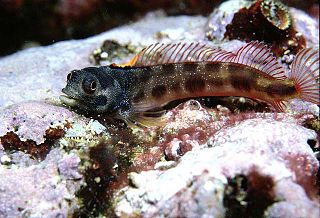 W
WThe Cortez barnacle blenny is a species of chaenopsid blenny found in the Gulf of California, in the eastern Pacific ocean. Males can reach a maximum length of 5.1 cm (2.0 in) SL, while females can reach a maximum length of 4 cm (1.6 in). The specific name honours the marine biologist Philip A. Hastings of the Scripps Institution of Oceanography.
 W
WThe clubhead blenny or clubhead barnacle blenny, is native to the eastern Pacific Ocean, where it occurs from the Gulf of California along the coast of Mexico south to Colombia and Ecuador.
 W
WThe blind goby is a species of fish in the goby family, the only species in the genus Typhlogobius. It is native to the coastlines of southern California in the United States and Baja California in Mexico, where it commonly inhabits the burrows of shrimp of the genus Callianassa. The adult of the species is completely blind and lacks pigmentation, while the juvenile has rudimentary eyes that help it find the shrimp burrows. This species can reach a length of 8.3 centimetres (3.3 in) TL.
 W
WThe blacknosed butterflyfish or barberfish, is a species of fish in the family Chaetodontidae, the butterfly fishes. It is found in the East Pacific, specifically around the Galápagos Islands and in the Sea of Cortez, and it sometimes acts as a cleaner fish. It is the only member of the genus Johnrandallia, named after the ichthyologist John E. Randall, but in the past it was commonly placed in Chaetodon.
 W
WThe yellow longnose butterflyfish or forceps butterflyfish, Forcipiger flavissimus, is a species of marine fish in the family Chaetodontidae.
 W
WClinocottus analis is a species of fish in the family Cottidae, one of the families of sculpins. It is known commonly as the woolly sculpin in English and the charrasco lanudo in Spanish. It is native to the eastern Pacific Ocean, where it occurs along the coastline of California and Baja California.
 W
WDactyloscopus byersi, the notchtail stargazer, is a species of sand stargazer native to the Pacific coast of Mexico to Panama where it can be found at depths of from 0 to 2 metres. It can reach a maximum length of 5 centimetres (2.0 in) NG. The specific name honours Major and Mrs. Joseph Byers, about whom no other information is available, since the name honours two people it should be Dactyloscopus byersorum.
 W
WThe giant damselfish inhabit rocky reefs, below the surf zone at depths of 1–25 m. They feed mainly on low-profile, attached algae. They defend both feeding and reproductive territories by driving off other fishes and divers who come too close. They are oviparous, and form distinct pairings during breeding. The eggs are demersal and adhere to the substrate. Males guard and aerate the eggs.
 W
WEpinephelus analogus, the spotted grouper, spotted cabrilla or rock bass, is a species of marine ray-finned fish, a grouper from the subfamily Epinephelinae which is part of the family Serranidae, which also includes the anthias and sea basses. It is found in the eastern Pacific Ocean where it is associated with reefs.
 W
WThe scalloped bonnethead is a rare, little-known species of hammerhead shark, and part of the family Sphyrnidae. Its other common names include the mallethead shark and the crown shark. It is found in tropical and subtropical waters in the eastern Pacific Ocean, from Mexico to Peru, and possibly as far north as the Gulf of California. It frequents inshore habitats over soft bottoms to a depth of 100 m, and also enters mangroves and estuaries.
 W
WThe threadfin jack or thread pompano is a species of coastal marine fish in the jack family Carangidae. The species inhabits the tropical waters of the eastern Pacific Ocean from Baja California in the north to Ecuador and the Galapagos Islands in the south. It is a moderately large fish, growing to 60 cm (24 in) and may be recognized by its filamentous dorsal and anal fin lobes. The threadfin jack inhabits both deeper coastal waters and inshore environments, including reefs and estuaries, where it preys on minute benthic and pelagic organisms, including small fishes and crustaceans. Very little is known about the ecology and reproductive cycle in the species. The threadfin jack is of importance to fisheries throughout its distribution, caught by hook-and-line and net methods and marketed fresh and salted, and is considered a very good table fish. The species was named Carangoides dorsalis by Theodore Gill 20 years before the name Caranx otrynter was introduced, but confusion with Vomer dorsalis led to the proposal of the new name to separate the two species.
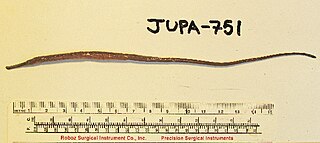 W
WThe kelp pipefish, Syngnathus californiensis, is a species of the pipefish. It inhabits the eastern Pacific from the Bodega Bay in northern California, United States, to southern Baja California, Mexico. It is a marine subtropical demersal fish, up to 50 centimetres (20 in) length.
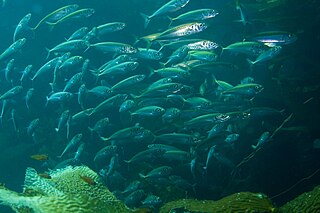 W
WThe Pacific jack mackerel, also known as the Californian jack mackerel or simply jack mackerel, is an abundant species of pelagic marine fish in the jack family, Carangidae. The species is distributed along the western coast of North America, ranging from Alaska in the north to the Gulf of California in the south, inhabiting both offshore and inshore environments. The Pacific jack mackerel is a moderately large fish, growing to a maximum recorded length of 81 cm, although commonly seen below 55 cm. It is very similar in appearance to other members of its genus, Trachurus, especially Trachurus murphyi, which was once thought to be a subspecies of T. symmetricus, and inhabits waters further south. Pacific jack mackerel travel in large schools, ranging up to 600 miles offshore and to depths of 400 m, generally moving through the upper part of the water column.
 W
WAbudefduf troschelii, the Pacific sergeant major or Panama sergeant major, is a species of damselfish belonging to the family Pomacentridae that can be identified by their pronounced black stripes on the lateral sides of the fish. Its specific name honors the zoologist Franz Hermann Troschel (1810-1882). It is native to the neritic pelagic zone of the shallow water coral reefs in the Eastern Pacific Ocean and they are an omnivorous species feeding on plankton and algae attached to their coral habitat. Abudefduf troschelii is a sister-species of A. saxatilis but have diverged from each other since the uplift of the isthmus of Panama, separated by the rise of the Panama land bridge 3.1 to 3.5 million years ago. Males, like in many other marine species, take care of and defend newborn A. troschelii after they have been hatched by eggs from the female. There are currently no major threats to the species and there is no indication of a current decline in its population size. The IUCN Red List lists this damselfish as being of “least concern”.
 W
WThe Mexican hornshark is a bullhead shark of the family Heterodontidae. This shark is grey-brown in color, with black spots scattered on the fins and body. It has a cylindrical trunk, conical head, and small spiracles behind the eyes. The snout of the Mexican hornshark is very round and blunt. Like all members of the order Heterodontiformes, this shark has fin spines in front of both of its dorsal fins. The first dorsal fin originates before the pectoral fins, while the second dorsal fin originates behind the pelvic fins. The Mexican hornshark reaches a maximum length around 70 cm, but usually reaches between 50 and 60 cm on average. Young hornsharks hatch around 14 cm.
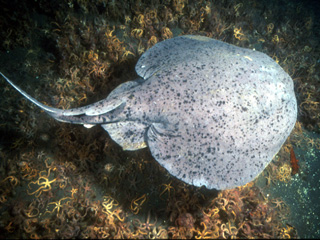 W
WTetronarce californica also known as the Pacific electric ray is a species of electric ray in the family Torpedinidae, endemic to the coastal waters of the northeastern Pacific Ocean from Baja California to British Columbia. It generally inhabits sandy flats, rocky reefs, and kelp forests from the surface to a depth of 200 m (660 ft), but has also been known to make forays into the open ocean. Measuring up to 1.4 m (4.6 ft) long, this species has smooth-rimmed spiracles and a dark gray, slate, or brown dorsal coloration, sometimes with dark spots. Its body form is typical of the genus, with a rounded pectoral fin disc wider than long and a thick tail bearing two dorsal fins of unequal size and a well-developed caudal fin.
 W
WThe Pacific sleeper shark is a sleeper shark of the family Somniosidae, found in the North Pacific on continental shelves and slopes in Arctic and temperate waters between latitudes 70°N and 22°N, from the surface to 2,000 metres (6,600 ft) deep. Records from southern oceans are likely misidentifications of relatives. Its length is up to 4.4 m (14 ft), although it could possibly reach lengths in excess of 7 m (23 ft).
 W
WThe Pacific white skate is a species of skate in the family Arhynchobatidae. It is one of the deepest-living of all skates, occurring at a depth of 800 to 2,938 m on the continental slope. It is native to the southeast Pacific Ocean from the Galapagos Islands to off Waldport, Oregon; an egg case and embryo has been collected from the Farallon Islands off San Francisco. Reports of it from the Sea of Okhotsk may represent a different species. Its species name, spinosissima, comes from the Latin spinosus meaning "thorny", referring to its covering of dermal denticles.
 W
WArothron meleagris, commonly known as the guineafowl puffer or golden puffer, is a pufferfish from the Indo-Pacific, and Eastern Pacific. It is occasionally harvested for the aquarium trade. It reaches 50 cm in length.
 W
WThe giant electric ray or Cortez electric ray is a species of numbfish, family Narcinidae, native to the eastern Pacific Ocean from the Gulf of California to Panama. It is found in shallow water on sandy bottoms and sometimes adjacent to reefs. This species is closely related to the lesser electric ray from the western Atlantic, and may represent the same species. The specific epithet entemedor seems to be the Spanish equivalent of "intimidator".
 W
WThe scoophead is a little-known species of hammerhead shark, part of the family Sphyrnidae. It inhabits the tropical waters of the western Atlantic Ocean, from Panama to southern Brazil, and in the eastern Pacific Ocean from the Gulf of California to Ecuador, and probably northern Peru, as well. It is found in shallow, inshore habitats.
 W
WThe sebastes goodei is a type of rockfish (Sebastidae) that lives mainly off the coast of western North America from Baja California to Vancouver. It is commonly called the Chilipepper rockfish and Chilipepper seaperch.
 W
WSelene brevoortii, the hairfin look down, also known as the airfin lookdown, Mexican lookdown or Pacific lookdown, is a species of carangid fish native to warmer parts of the East Pacific where it is found from southernmost California, United States to northern Peru. This species is generally found close to the coast at depths of less than 50 m (160 ft). They grow to 38 cm (15 in) in fork length. It is of minor importance to local commercial fisheries, but is popular as a gamefish. Its specific name honours the American book collector, numismatist, amateur naturalist and friend of Theodore N. Gills J. Carson Brevoort (1817-1887) for his interest in the fishes of the family Carangidae.
 W
WSmallhead stickleback is a fish species, which widespread in the basin of the Pacific Ocean: Japan, also Mexico. Freshwater demersal fish, up to 5.5 cm length. Habits small streams, where feeds on aquatic insects and other invertebrates.
 W
WThe sicklefin smooth-hound is a houndshark of the family Triakidae. Even some species look similar to Carcharhinus family, mustelus second dorsal fin is much bigger. It is found on the continental shelves of the eastern Pacific, between latitudes 33° N and 7° N. The difference between sharptooth smooth-hound and mustelus lunulatus, is that the lunulatus second dorsal fin origin far in advance of the anal fin. It can reach a length of up to 1.7 m. The reproduction of this shark is ovoviviparous.
 W
WThe Mexican barred snapper is a species of snapper native to the Pacific coast of Central and northern South America from Mexico to Colombia. They inhabit rocky areas near coral reefs at depths from very shallow waters to around 50 m (160 ft). This species grows to 92 cm (36 in) in total length, though most only reach 50 cm (20 in). The heaviest known example of this species weighed 9.6 kg (21 lb). This species is important to local inhabitants as a food fish and is also sought as a game fish. It can also be found displayed in public aquaria. This species is the only known member of its genus.
 W
WThe Mazatlan sole is a sole of the genus Achirus native to the eastern Pacific from northern Baja California and the Gulf of California to northernmost Peru. This demersal species growth up to 20 cm (7.9 in). It is found at depths of 1–60 m in coastal lagoons and fresh water. Its diet consists of crustaceans, small fishes, polychaetes, and occasionally detritus.
 W
WThe spotted sand bass is a species of marine ray-finned fish, a sea bass from the subfamily Serraninae, classified as part of the family Serranidae which includes the groupers and anthias. It is found in the central eastern Pacific Ocean.
 W
WThe diamond stingray is a species of stingray in the family Dasyatidae. It is found in the coastal waters of the eastern Pacific Ocean from southern California to northern Chile, and around the Galápagos and Hawaiian Islands. This bottom-dweller generally inhabits sandy or muddy flats near rocky reefs and kelp forests, to a depth of 30 m (98 ft), though off Hawaii it may range considerably deeper. As its common name suggests, this species has an angular, diamond-shaped pectoral fin disc that is plain brown or gray above, with rows of tubercles along the midline and on the "shoulders". The long, whip-like tail has both dorsal and ventral fin folds, which distinguish this ray from the closely similar longtail stingray (D. longa). It typically grows to 1 m (3.3 ft) across.
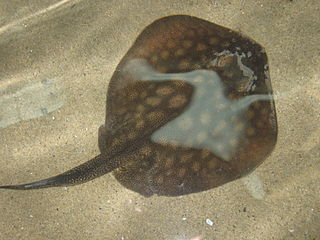 W
WThe round stingray or Haller's round ray and Little round stingray is a species of round ray, family Urotrygonidae, found in the coastal waters of the eastern Pacific Ocean. It is a small, common ray that feeds mostly on benthic invertebrates. On the beaches of southern California, it is responsible for numerous injuries to bathers, who are stung when they accidentally step on the fish. The wound caused by its venomous spine can be painful, but is non-fatal.
 W
WThe bullseye round stingray, also known as the reticulated round ray, or spot-on-spot round ray, is a species of cartilaginous fish in the family Urotrygonidae. It is endemic to Mexico. Its natural habitats are shallow seas, subtidal aquatic beds, coral reefs, estuarine waters, intertidal marshes, and coastal saline lagoons. It is threatened by habitat loss.
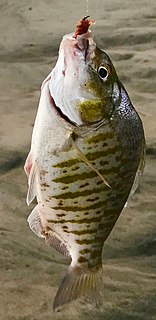 W
WThe barred surfperch is a species of surfperch native to inshore waters from northern California, United States to southern Baja California, Mexico. This species can reach a length of 43 centimetres (17 in) TL though most do not exceed 30 centimetres (12 in) TL. The maximum recorded weight is 2.0 kilograms (4.4 lb). Like other surfperches, it gives birth to live young. The diet of the barred surfperch consists predominantly of sand crabs . According to the California Department of Fish and Game, Barred Surfperch can be identified by bars and spots on sides which are often unbarred, as well as the absence of red tail.
 W
WThe Calico surfperch is a species of surfperch native to the eastern Pacific Ocean. They are primarily found along the west coast of the United States. The specific name honours the American fisheries biologist Walter Koelz (1895-1989). According to the California Department of Fish and Game, Calico surfperch are distinguished from other surfperches by a noticeable notch between the dorsal soft and hard rays. Further, the dorsal hard and soft rays are of equal length and sides often have broken bars and spots on each side. The usual length is around 30 cm.
 W
WThe thornback guitarfish is a species of ray in the family Platyrhinidae, and the only member of its genus. Despite its name and appearance, it is more closely related to electric rays than to true guitarfishes of the family Rhinobatidae. This species ranges from Tomales Bay to the Gulf of California, generally in inshore waters no deeper than 6 m (20 ft). It can be found on or buried in sand or mud, or in and near kelp beds. Reaching 91 cm (36 in) in length, the thornback guitarfish has a heart-shaped pectoral fin disc and a long, robust tail bearing two posteriorly positioned dorsal fins and a well-developed caudal fin. The most distinctive traits of this plain-colored ray are the three parallel rows of large, hooked thorns that start from the middle of the back and run onto the tail.
 W
WThe gafftopsail pompano is a species of jack in the family Carangidae. It is found in the eastern Pacific.
 W
WThe hornyhead turbot is a flatfish of the family Pleuronectidae. It is a demersal fish that lives on soft sand and mud bottoms at depths of between 9 and 200 metres. Its native habitat is the subtropical waters of the Eastern Pacific, from Point Reyes in California to Magdalena Bay in Baja California, and the northern and central eastern parts of the Gulf of California. It can grow up to 37 centimetres (15 in) in length.